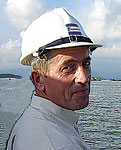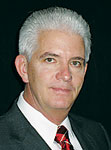 |
| Granet |
 |
| Klemencic |
 |
| Burns |
 |
| Totten |
 |
| Gottfried |
 |
| Jee |
Vietnam now joins the ranks of nations with pioneering cable-stayed bridges, thanks to innovative team efforts led by , site manager for Freyssinet S.A., the cable contractor on the 903-meter-long Bai Chay Bridge. It is the worlds longest that has a centrally supported, concrete cable-stayed span. The design also incorporates novel compact stay cables that reduce wind loading by trimming the support systems area. Granet led site work to implement the Paris-based firms concept for the first time. He crammed an equal amount of stay cable steel into 35% less space, allowing the bridge to withstand higher-than-planned wind forces without costly structural changes. , chairman of the Council on Tall Buildings and Urban Habitat, is preparing to turn over the reins of this important research and advocacy group for skyscrapers around the world, leaving behind a stronger and more influential organization than the one he took over in 2001. Klemencic, president of structural engineer Magnusson Klemencic Associates, worked without pay to shore up the councils finances and reputation. Both had begun to slide shortly after the 1999 retirement of the councils founder, the late Lynn Beedle. The council, founded in 1969, maintains the official list of the worlds 100 tallest buildings and has become the nexus for information on skyscrapers. Klemencic attracted more design and construction practitioners and material and product suppliers into the group and acted quickly to dispel public concerns and misconceptions about skyscraper safety after the 9/11 terrorist attacks. The U.S. Air Forces Air Combat Command, the services largest command, had struggled to manage a construction program where 80% of global projects were over budget and 75% were behind schedule. Command facilities typically took twice as long to complete as comparable structures in the private sector. , recently retired Air Force brigadier general and the commands former engineer director, drove an impressive turnaround. More than 75% of its projects are ahead of drastically shortened schedules and costs have dropped, running on average just one-third of 1% over budget. Burns made process changes that include 3-D modeling and a concentrated push to finish work in a projects last 90 days. The latter innovation has been adopted in construction by other Air Force commands and by the U.S. Navy and Army Corps of Engineers. Burns is now vice president and general manager of the federal contracting group in Washington, D.C., for M.A. Mortenson Co. , president of Cives Steel Co.s northern division, knew from the outset that the 42-story Hearst Building in Manhattan was a job that was off the charts. For the entire building to be a success, it was critical for the steel contractor to fabricate and erect, with the precision of a Swiss watchmaker, the 11,900-ton steel structure, including a 32-story perimeter diagrid frame. Tolerances were extremely tight and there was no forgiveness for error. For Totten and his team, including erector Cornell & Co., any mistake would mean that the stainless steel and glass curtain wall, which mimics the diagrid, would not fit like a glove. To ensure a perfect fit, Cives shared digital files with the curtain wall supplier, a rare move in building construction. The strategy worked and the highrise is on course to open this spring. The Leadership in Energy and Environmental Design Rating System, known as LEED, has become the standard of sustainability for buildings, adopted and even mandated by more and more owners. Despite the systems growing popularity, many construction industry participants complained that its administrative complexity was a barrier to getting more structures certified as meeting environmental and energy standards. , co-founder of the The U.S. Green Building Council which created LEED and president of his own consulting business, led the effort to revamp the rating tool. To qualify for a LEED rating, the new system moves from paper-intensive requirements to an online submittal and review process that significantly reduces required documentation. It also splits the submittal into design and construction phases, allowing building teams the opportunity for council reviewers to offer interim project and process feedback. , president of his own San Francisco-based civil engineering firm, is largely responsible for the successful seismic retrofit of the southern approach of the citys famed Golden Gate Bridge. The project, part of a decade-long effort to prepare the signature span for the next big one, was completed on schedule and within 3% of the $122.3-million contract price. Jees interventions were innovative and efficient, constructible and respectful of the Golden Gates iconic status. Jee led the team that developed the unique energy dissipation devices to reduce the amount of required reinforcement and its innovative approach to reinforcing bridge pylons without altering their appearance. Jee also developed a reusable system to temporarily support the south viaduct under live traffic conditions and to incorporate temporary foundations into permanent ones.
